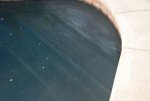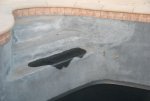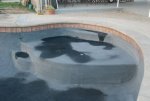Hello!
New to this site and pool ownership. Really excited that we may be able to get some good advice.
Just moved and finished recoping, replumbing (new auto-fill, vacuum, & skimmer), and resurfacing our pool because the previous owner had left the pool empty for over 5 years. Tsk! Tsk!
We went with pour in place coping to help with the perspective since the pool was so large and choose an Amber Beige color to add to the aggregate. I understand that the added color mixes with the aggregate color so the final color will not match the sample.
?s: How long should the pour in place cure? Is there anything that can be done to enhance the color? What type of sealer should be used to protect the coping from either chlorine or salt water?
We were originally only having the main lines replumbed, but our contractor surprised us and added a split drain. Now it looks like we have an option of keeping the pool chlorinated or changing it to salt water since there are no more copper lines.
?s: Which system is easiest to care for? Are there any added benefits between one or the other? How about issues? What filters/pumps work best with each system?
I really wanted a black bottom pool but was dissuaded from it because of mottling and algae growth. However, our contractor introduced me to pebble & quartz finishes stating that because the aggregate contains the color instead of just the plaster, the mottling issues do not occur.
The pool was completed with an Onyx Quartz finish which contains a medium gray plaster with black and blue quartz pieces. The acid was just added to the pool yesterday so we are now in the process of brushing for the next 7 days helping remove the top layer of the plaster to get the aggregate to appear.
I was not super worried about the color of the plaster when it was filled because the dust made it look a light grey, but now that we are brushing... the plaster looks pretty black and we can't quite see the aggregate yet. Great for the color design I was looking for, but now worried about the upkeep.
?s: Is brushing 2-3 times a day sufficient to get the best results from the acid bath? Are either cholrine or salt water systems safe to use with the darker finish? Which water system will help prevent algae growth best? Will mottling still occur with the darker quartz aggregate finish?
Any suggestions/comments will be much appreciated! We started getting concerned when the contractor's acid guy who I guess also cleans pools started making side comments about our choices. Not sure if we need to be concerned or just be diligent with our upkeep.
THANKS!!!!!
New to this site and pool ownership. Really excited that we may be able to get some good advice.
Just moved and finished recoping, replumbing (new auto-fill, vacuum, & skimmer), and resurfacing our pool because the previous owner had left the pool empty for over 5 years. Tsk! Tsk!
We went with pour in place coping to help with the perspective since the pool was so large and choose an Amber Beige color to add to the aggregate. I understand that the added color mixes with the aggregate color so the final color will not match the sample.
?s: How long should the pour in place cure? Is there anything that can be done to enhance the color? What type of sealer should be used to protect the coping from either chlorine or salt water?
We were originally only having the main lines replumbed, but our contractor surprised us and added a split drain. Now it looks like we have an option of keeping the pool chlorinated or changing it to salt water since there are no more copper lines.
?s: Which system is easiest to care for? Are there any added benefits between one or the other? How about issues? What filters/pumps work best with each system?
I really wanted a black bottom pool but was dissuaded from it because of mottling and algae growth. However, our contractor introduced me to pebble & quartz finishes stating that because the aggregate contains the color instead of just the plaster, the mottling issues do not occur.
The pool was completed with an Onyx Quartz finish which contains a medium gray plaster with black and blue quartz pieces. The acid was just added to the pool yesterday so we are now in the process of brushing for the next 7 days helping remove the top layer of the plaster to get the aggregate to appear.
I was not super worried about the color of the plaster when it was filled because the dust made it look a light grey, but now that we are brushing... the plaster looks pretty black and we can't quite see the aggregate yet. Great for the color design I was looking for, but now worried about the upkeep.
?s: Is brushing 2-3 times a day sufficient to get the best results from the acid bath? Are either cholrine or salt water systems safe to use with the darker finish? Which water system will help prevent algae growth best? Will mottling still occur with the darker quartz aggregate finish?
Any suggestions/comments will be much appreciated! We started getting concerned when the contractor's acid guy who I guess also cleans pools started making side comments about our choices. Not sure if we need to be concerned or just be diligent with our upkeep.
THANKS!!!!!




